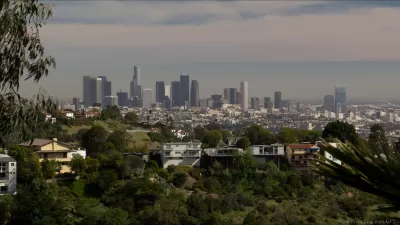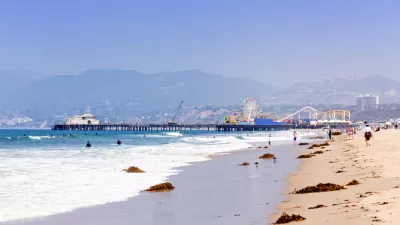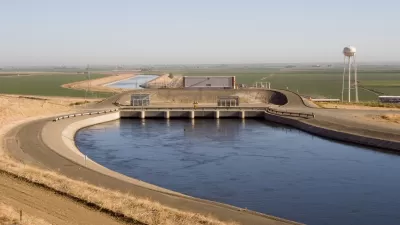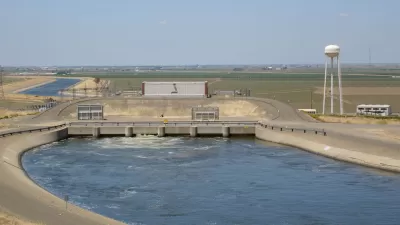Closing out the "Just Add Water" lecture series, four panelists came together to discuss climate change, cultural shifts for sustainability, and adapting Los Angeles's urban fabric for greater climate resiliency in the future.

With average summer temperatures expected to reach a sweltering 89.83 degrees Fahrenheit by 2100, how are people going to "survive and thrive in a hotter Los Angeles, and adapt to climate change and increasingly stressed water supplies, all while creating a more livable, vibrant city?"
A lecture organized by Jon Christensen, at the Los Angeles Natural History Museum brought together four panelists representing different perspectives: Frances Anderton, host of KCRW’s "DnA: Design & Architecture," Alex Hall, professor at UCLA Department of Atmospheric and Oceanic Sciences, Dr. John Harris, chief curator at the Page Museum and head of vertebrate studies at NHM, and finally Christopher Hawthorne, architecture critic for The Los Angeles Times.
With the setting sun as backdrop, Alex Hall delved into his research regarding how different micro-climates are affected by climate change, as per the United Nation's Intergovernmental Panel on Climate Change (IPCC) Emissions Scenarios. Hall found that by mid-century Southern California temperature changes will be felt more strongly inland than on the coast, and summer will include two to three times more "extremely hot days," when daytime temperatures soar about 95 degrees Fahrenheit. In addition, regardless of any action we take to reduce greenhouse gas emissions, by mid-century we will feel effects of climate change. However, depending on the severity of our reductions, we could see a plateau by the end of the century. This infographic from the World Resources Institute nicely summarizes the four different climate futures, based on these varying levels of emissions and timing of reductions.
While Hall uses high-tech methods to understand climate change, geology and archeology can also reveal an important historic narrative. In the past, climate change occurred, but at a far slower rate than we are currently witnessing. Today, with exponential change and an urbanized landscape, greater barriers exist for animal's natural migration and adaption. This grim vision matched Hall's description of the future, laying the groundwork for a vehement discussion on how to adapt our built environment to climate change.
The panelists agreed Los Angeles architecture needs to sync with the realities of scarcity in the Los Angeles region. Los Angeles's cultural and architectural icons—cars, pools, lawns, freeways—developed in a time of post-war abundance when long-term resource conservation and resiliency was not in the forefront of the American public. Hawthorne discussed how these icons are loosing their value and memory in a recent Los Angeles Times post, reflecting on Alfredo Barsuglia’s Social Pool.
With the current climate crisis on our hands, architecture in Los Angeles must better recognize the unique, local micro-climate conditions. Given that predicted changes are informed by location within the sprawling metropolis, all neighborhoods will be impacted differently. Certain styles like the outdated and wasteful pitched roof, imported from the Midwest, sheds rain that rarely falls. According to Hawthorne, these should be abandoned for concave rain-collecting roofs, tackling the growing scarcity of water. Anderton emphasized the need to implement architecture from drier climates as found in Spain, France, and Greece. These older cultures have perfected materials and styles that address efficiency, shade, and cooling. Indeed, there is no need to wait and rely on technology for an architectural solution, explained Anderton, as it already exists in history.
With regard to the current wasteful landscaping, Hall pushed Los Angeles to weave realistic Southern California plants into its urban fabric—instead of green lawns that would naturally never survive in this arid biome. This integration would inform the public which species are native to Southern California, and confront the reality of the existing desert landscape under the asphalt roads and urban infrastructure.
In his closing thoughts, Harris suggested better education standards with regard to climate change and sustainability, as children learn at school and pass their new-found knowledge along to their families. This particularly struck a chord with me as I vividly remember signing a recycling pledge in kindergarten, inspiring me to sort and take out the recycling every week—a chore I did passionately.
With those wise words, the "Just Add Water" series came to a close, and everybody walked out dreaming of the future of Los Angeles in a time of challenging changes.

Alabama: Trump Terminates Settlements for Black Communities Harmed By Raw Sewage
Trump deemed the landmark civil rights agreement “illegal DEI and environmental justice policy.”

Study: Maui’s Plan to Convert Vacation Rentals to Long-Term Housing Could Cause Nearly $1 Billion Economic Loss
The plan would reduce visitor accommodation by 25% resulting in 1,900 jobs lost.

Planetizen Federal Action Tracker
A weekly monitor of how Trump’s orders and actions are impacting planners and planning in America.

Wind Energy on the Rise Despite Federal Policy Reversal
The Trump administration is revoking federal support for renewable energy, but demand for new projects continues unabated.

Passengers Flock to Caltrain After Electrification
The new electric trains are running faster and more reliably, leading to strong ridership growth on the Bay Area rail system.

Texas Churches Rally Behind ‘Yes in God’s Back Yard’ Legislation
Religious leaders want the state to reduce zoning regulations to streamline leasing church-owned land to housing developers.
Urban Design for Planners 1: Software Tools
This six-course series explores essential urban design concepts using open source software and equips planners with the tools they need to participate fully in the urban design process.
Planning for Universal Design
Learn the tools for implementing Universal Design in planning regulations.
Caltrans
Smith Gee Studio
Institute for Housing and Urban Development Studies (IHS)
City of Grandview
Harvard GSD Executive Education
Toledo-Lucas County Plan Commissions
Salt Lake City
NYU Wagner Graduate School of Public Service






























